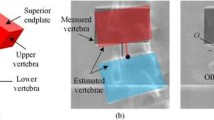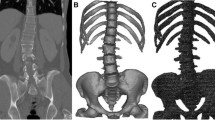Abstract
In multi-body models of scoliotic spine, personalization of mechanical properties of joints significantly improves reconstruction of the spine shape. In personalization methods based on lateral bending test, simulation of bending positions is an essential step. To simulate, a force is exerted on the spine model in the erect position. The line of action of the force affects the moment of the force about the joints and thus, if not correctly identified, causes over/underestimation of mechanical properties. Therefore, we aimed to identify the line of action, which has got little attention in previous studies. An in-depth analysis was performed on the scoliotic spine movement from the erect to four spine positions in the frontal plane by using pre-operative X-rays of 18 adolescent idiopathic scoliosis (AIS) patients. To study the movement, the spine curvature was considered as a 2D chain of micro-scale motion segments (MMSs) comprising rigid links and 1-degree-of-freedom (DOF) rotary joints. It was found that two MMSs representing the inflection points of the erect spine had almost no rotation (0.0028° ± 0.0021°) in the movement. The small rotation can be justified by weak moment of the force about these MMSs due to very small moment arm. Therefore, in the frontal plane, the line of action of the force to simulate the left/right bending position was defined as the line that passes through these MMSs in the left/right bending position. Through personalization of a 3D spine model for our patients, we demonstrated that our line of action could result in good estimates of the spine shape in the bending positions and other positions not included in the personalization, supporting our proposed line of action.











Similar content being viewed by others
Notes
The amplitude is measured on the X-rays. It is ‘the angle between the line drawn through the mid points of T1 and L5 and the normal to the line drawn through the superior tips of the left and right iliac crests’ [26].
The example is based on the measurements done on the X-rays of a scoliotic patient included in this study. The measurements and their accuracy and reliability are explained in Sect. 2.2.
144 MMSs = 1 MMS × 2 regions × 4 positions × 18 patients.
504 vertebrae = 14 vertebrae excluding L4 × 2 positions × 18 patients.
References
Abouhossein A, Weisse B, Ferguson SJ (2011) A multibody modelling approach to determine load sharing between passive elements of the lumbar spine. Comput Methods Biomech Biomed Eng 14:527–537
Aubin C-E, Petit Y, Stokes I, Poulin F, Gardner-Morse M, Labelle H (2003) Biomechanical modeling of posterior instrumentation of the scoliotic spine. Comput Methods Biomech Biomed Eng 6:27–32
Aubin CE, Labelle H, Chevrefils C, Desroches G, Clin J, Eng ABM (2008) Preoperative planning simulator for spinal deformity surgeries. Spine 33:2143–2152
Chalmers E, Westover L, Jacob J, Donauer A, Zhao V, Parent E, Moreau M, Mahood J, Hedden D, Lou EM (2015) Predicting success or failure of brace treatment for adolescents with idiopathic scoliosis. Med Biol Eng Comput 53:1001–1009. doi:10.1007/s11517-015-1306-7
Cheriet F, Dansereau J, Petit Y, Aubin C-E, Labelle H, De Guise JA (1999) Towards the self-calibration of a multiview radiographic imaging system for the 3D reconstruction of the human spine and rib cage. Int J Pattern Recognit Artif Intell 13:761–779
Christophy M, Senan NAF, Lotz JC, O’Reilly OM (2012) A musculoskeletal model for the lumbar spine. Biomech Model Mechanobiol 11:19–34
Colton T (1974) Statistics in medicine. Little, Brown, Boston 164
Denavit J (1955) A kinematic notation for lower-pair mechanisms based on matrices. Trans ASME J Appl Mech 22:215–221
Desroches G, Aubin C-E, Sucato DJ, Rivard C-H (2007) Simulation of an anterior spine instrumentation in adolescent idiopathic scoliosis using a flexible multi-body model. Med Biol Eng Comput 45:759–768
Duke K, Aubin C-E, Dansereau J, Labelle H (2005) Biomechanical simulations of scoliotic spine correction due to prone position and anaesthesia prior to surgical instrumentation. Clin Biomech 20:923–931
Gardner-Morse M, Stokes IA (1994) Three-dimensional simulations of the scoliosis derotation maneuver with Cotrel-Dubousset instrumentation. J Biomech 27:177–181
Huynh K, Gibson I, Jagdish B, Lu W (2015) Development and validation of a discretised multi-body spine model in LifeMOD for biodynamic behaviour simulation. Comput Methods Biomech Biomed Eng 18:175–184
Jalalian A, Gibson I, Tay EH (2013) Computational biomechanical modeling of scoliotic spine: challenges and opportunities. Spine Deformity 1:401–411
Jalalian A, Gibson I, Tay EH, Liu G (2014) A review of computer simulation of spine biomechanics for the treatment of scoliosis. In: The 5th TSME international conference on mechanical engineering, The Empress, Chiang Mai, Thailand, pp 17–19
Jalalian A, Tay EH, Arastehfar S, Liu G (accepted) A patient-specific multibody kinematic model for representation of the scoliotic spine movement in frontal plane of the human body. Multibody Syst Dyn
Jalalian A, Tay EH, Liu G (2016) Data mining in medicine: relationship of scoliotic spine curvature to the movement sequence of lateral bending positions. In: 15th Industrial conference on data mining ICDM 2016, New York, USA, 12–14 July 2016
Jalalian A, Tay EH, Liu G (2016) A hypothesis about line of action of the force exerted on spine based on lateral bending test in personalized scoliotic spine models. In: The Canadian Society for mechanical engineering international congress, Kelowna, BC, Canada, 26–29 June 2016
Kadoury S, Shen J, Parent S (2014) Global geometric torsion estimation in adolescent idiopathic scoliosis. Med Biol Eng Comput 52:309–319. doi:10.1007/s11517-013-1132-8
Keenan BE, Izatt MT, Askin GN, Labrom RD, Pettet GJ, Pearcy MJ, Adam CJ (2014) Segmental torso masses in adolescent idiopathic scoliosis. Clin Biomech 29:773–779
Lenke L (2000) SRS terminology committee and working group on spinal classification revised glossary of terms. http://www.srs.org/professionals/glossary/SRS_revised_glossary_of_terms.htm. Accessed 21 July 2015
Lenke LG, Betz RR, Harms J, Bridwell KH, Clements DH, Lowe TG, Blanke K (2001) Adolescent idiopathic scoliosis a new classification to determine extent of spinal arthrodesis. J Bone Joint Surg 83:1169–1181
Oxland TR, Lin RM, Panjabi MM (1992) Three-dimensional mechanical properties of the thoracolumbar junction. J Orthop Res 10:573–580
Panjabi MM, Brand RA Jr, White AA III (1976) Three-dimensional flexibility and stiffness properties of the human thoracic spine. J Biomech 9:185–192
Perret C, Poiraudeau S, Fermanian J, Revel M (2001) Pelvic mobility when bending forward in standing position: validity and reliability of 2 motion analysis devices. Arch Phys Med Rehabil 82:221–226
Petit Y, Aubin C-E, Labelle H (2004) Spinal shape changes resulting from scoliotic spine surgical instrumentation expressed as intervertebral rotations and centers of rotation. J Biomech 37:173–180
Petit Y, Aubin C, Labelle H (2004) Patient-specific mechanical properties of a flexible multi-body model of the scoliotic spine. Med Biol Eng Comput 42:55–60
Sponseller PD, Flynn JM, Newton PO, Marks MC, Bastrom TP, Petcharaporn M, McElroy MJ, Lonner BS, Betz RR, Group HS (2012) The association of patient characteristics and spinal curve parameters with Lenke classification types. Spine 37:1138–1141
Stokes IA (1994) Three-dimensional terminology of spinal deformity: a report presented to the Scoliosis Research Society by The Scoliosis Research Society Working Group on 3-D terminology of spinal deformity. Spine 19:236–248
Wagnac E, Arnoux P-J, Garo A, Aubin C-E (2012) Finite element analysis of the influence of loading rate on a model of the full lumbar spine under dynamic loading conditions. Med Biol Eng Comput 50:903–915. doi:10.1007/s11517-012-0908-6
Wong KW, Leong JC, M-k Chan, Luk KD, Lu WW (2004) The flexion–extension profile of lumbar spine in 100 healthy volunteers. Spine 29:1636–1641
Author information
Authors and Affiliations
Corresponding author
Rights and permissions
About this article
Cite this article
Jalalian, A., Tay, F.E., Arastehfar, S. et al. Finding line of action of the force exerted on erect spine based on lateral bending test in personalization of scoliotic spine models. Med Biol Eng Comput 55, 673–684 (2017). https://doi.org/10.1007/s11517-016-1550-5
Received:
Accepted:
Published:
Issue Date:
DOI: https://doi.org/10.1007/s11517-016-1550-5




